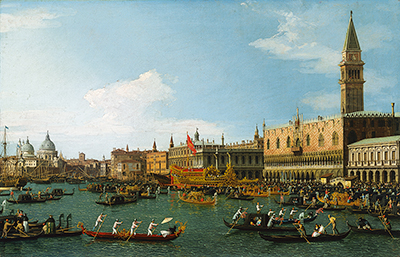Giovanni Antonio Canal, more commonly known as Canaletto created The Bucintoro of The Basin of San Marco on Ascension Day, celebrating two famous festivals that were held every year in Venice during the 18th century: The gondola races and the Wedding of the Sea ceremony. Canaletto produced this particular piece during the height of his success around 1740.
Canaletto captured the beauty of the large red and gold adorned boat which represented the Serenissima and Venice's symbolic marriage to the sea. In fitting with Canaletto's usual style, this particular piece displays his talent for depicting, magnificent Italian landscapes and seascapes expertly capturing life in Venice at the time and the atmosphere emitting from the crowds during the grand Venetian festivals. Canaletto, a native Venetian himself, was well known for his very precise attention to detail in his creations as demonstrated in this painting along with his love for contrasting light and shadow. In this piece, he skilfully applies highlights to give the illusion of light. Canaletto also used textured brushwork to make his paintings come alive, such as this one.
One of his favoured techniques was to sketch the outlines and details of buildings beforehand. He was also known to sketch straight lines with a ruler to show reflections of the buildings in the water. Canaletto preferred to complete his paintings outdoors to truly capture the light and beauty of the architecture of the buildings that he painted, which was unusual for the time as the majority of artists often worked indoors within a studio. The benefits of this are that his paintings, such as this one, display more detailed depictions of the buildings and people within the city and the detail is much sharper bringing the city alive. The surfaces he has painted in this creation are built up with varying tones and strength of colour and the sky comes alive with light with the people skilfully created openly to make them come to life within the painting.
Canaletto was well known for creating paintings that appealed to travelling wealthy people who wanted a momentum of their trip to take back home and this painting is typical of Canaletto’s topographical style. His paintings always brought a high price at auctions and were well sought after. Canaletto was inspired to paint his creations such as this one by Giovanni Paolo Panini, Caspar van Wittel and Luca Carlevarijs who influenced his early painting style. This painting is dated at circa 1740 and can now be found in the extensive collection of the National Gallery in London, UK, where you will find a number of other artists from the early Renaissance up to the start of the 20th century, such as the likes of Titian, Vermeer, Georges Seurat and Claude. This venue is located in the famous Trafalgar Square in the centre of the city and hosts one of the best collections of art in the city, competing well against anything to be found anywhere in Europe.




